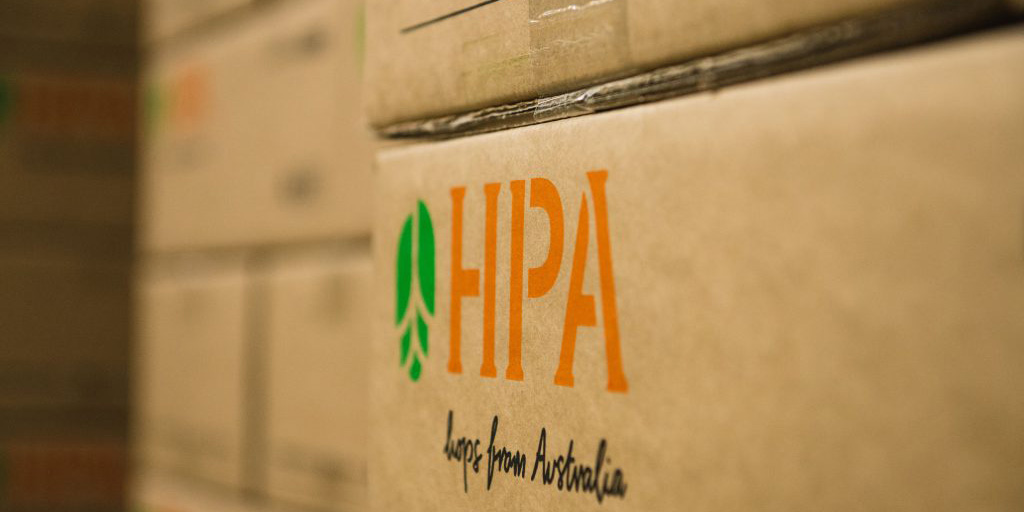Hop storage techniques that preserve impact in beer May 2020
Hop Products Australia explained how to use a hop Certificate of Analysis in this article. A CoA describes the hops at the time of packaging. To preserve their impact in beer, HPA seals their hops in oxygen barrier laminated foils that have been back-flushed with carbon dioxide. But the degradation of alpha acids and essential oils happens very quickly once the foils are opened and the hops are exposed to oxygen. Luckily, there are some simple and cost effective hop storage techniques that brewers can take to keep their hops fresh and their beers consistent.

Hop storage
Unopened foils will last up to three years in storage temperatures of 1°C-5°C, but not every foil will be used in its entirety as soon as it’s opened.
Once a foil is opened the oxidisation of alpha acids begins almost immediately, and the more volatile oils (ie. Myrcene) are rapidly lost. To limit these chemical changes that directly effect impact in beer HPA recommends that brewers:
- Refrigerate hops in storage temperatures of 1°C-5°C (or lower)
- Reseal opened foils
- Date and time stamp opened foils
Refrigeration
Hops should be stored in temperatures of 1°C-5°C (or lower) at all times. Storage stability varies from variety to variety. Each hop has different levels of natural antioxidents, and varying susceptibility to oxidation. This can cause them to lose quality faster, even under identical storage conditions.
Regardless of variety, exposure to oxygen, heat and light should be avoided to preserve impact in beer. The quality of hops exposed to high temperatures will rapidly degrade. The higher the temperature, the more they will degrade. This effect has been shown to halve for every 15°C drop in temperature. And hops exposed to high levels of UV light can produce off or cheesy flavours in beer.
Hop pellets degrade more slowly in foils than whole hops. Their compact shape keeps out a lot of oxygen and allows them to be easily vacuum packed to further slow the loss of alpha acids and oils. They also take up less storage space, making it more practical to keep them refrigerated.
Resealing vs Wrapping
Brewers should not open foils until necessary. Once opened, the best thing to do is reseal any remaining hops in the foil using a commercial chamber vacuum sealer and return to storage temperatures of 1°C-5°C (or lower).
The two key features a brewer should look for in a vacuum sealer are to ability to comfortably hold a 5kg foil, and pre-installed inert gas back-flushing capability or the option to fit a separate gas back-flushing kit. These devices start at AUD$5,000 when brand new (example here), but you can often source them second hand from restaurants.
They are a particularly good investment for those with brewpubs, as it can be used in both the brewery and the kitchen. Ideally, brewers should reseal the original foils to retain the benefits of the oxygen barrier. But the next best thing is commercial grade vacuum bags. This method should result in a foil or bag that is tightly sealed while still allowing the hops to move around.
If vacuum sealing is not an option, brewers should simply squeeze all oxygen out of the foil then wrap and tape so it is as airtight as possible. The hops should then be placed back in storage temperatures of 1°C-5°C (or lower).
Best Before Date
Ideally, once a foil has been opened the hops should be used within a few days to minimise loss of alpha acids and oils. However, any remaining hops that have been resealed or wrapped in their original foil should last up to two months depending on the variety and overall exposure to oxygen.
If the re-sealed or wrapped hops are no longer in their original foils, brewers should label them with their variety, lot code, crop year, alpha acid percentage and weight before returning them to storage temperatures of 1°C-5°C (or lower). This will help determine their expected impact in beer at time of use.
One common test to determine the storage stability of a particular variety is to measure the amount of alpha acids lost over a six month period at 20°C. There is a direct relationship between the losses and the Hop Storage Index (HSI).
If you know original alpha acids and the HSI, you can predict alpha acid losses and adjust your recipe accordingly to create more consistent beers. Click here for step-by-step instructions.
If you have any questions about storing hops, you can contact your Hop Products Australia sales rep for more information.

